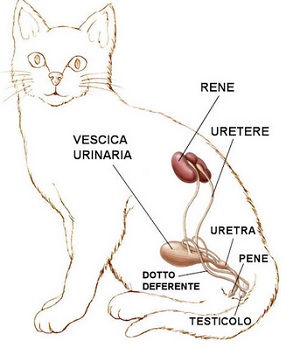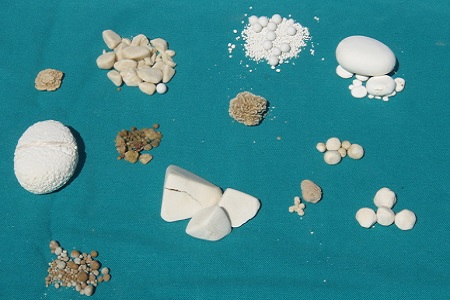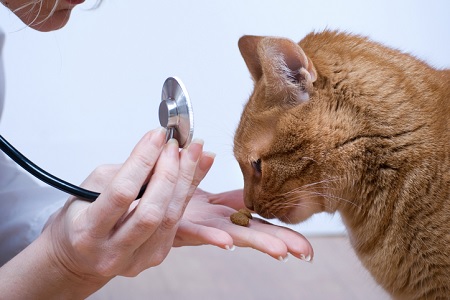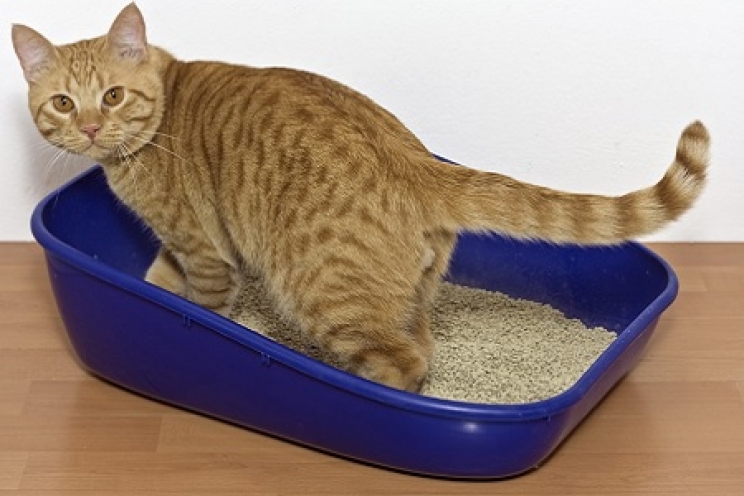Cats often experience annoying problems affecting the urinary tract, especially the bladder and urethra. It may happen, in fact, that he begins to "do it" around the house - refusing the idea of using the litter box - he complains, licks his genitals persistently and produces few urine, often with drops of blood. But what are the causes and how do we intervene?
FLUTD: what is it?
Probably some of us have already heard this strange acronym. "FLUTD" stands for "Feline Lower Urinary Tract Disease", or "Pathology of the lower urinary tract of the cat".
First of all, a brief anatomical recap is necessary: the bladder - as we all know - is a bag positioned on the lower abdomen, which receives the urine produced by the kidneys through the two long ureters, while the urethra is the thin conduit that carries the "Pee" from the bladder to the outside.
The term FLUTD, therefore, is used in a general way to encompass all the ailments that can affect the bladder and urethra. In particular, the causes of FLUTD can be divided into two main categories: obstructive and non-obstructive.
Causes of non-obstructive FLUTD might be:
- Non-obstructive idiopathic cystitis (FIC): the term "idiopathic" is used in medicine to refer to all those disorders that are really ascertained, but whose causes cannot be identified. Cystitis is generally defined as an inflammation of the bladder, which can occur in the presence of numerous factors. In the specific case of FIC, however, the bladder probably becomes inflamed for other problems such as stress. In this case, the brain sends signals to the bladder, increasing the production of substances that trigger inflammation. Another hypothesis underlying the FIC includes the reduction of the number of glycosaminoglycans or GAGs, of the substances normally present on the walls of the bladder, which have the function of protecting it from bacteria. When the GAGs decrease, the bacteria can take over and multiply, thus creating an infection;
- Bacterial cystitis: occur when bacteria - especially those present in the intestinal tract - reach the bladder or urethra and manage to multiply, generating a rather painful infection;
- Stones in the bladder: just like in humans, our four-legged friends can also meet this problem, which appears when two possible substances, struvite and oxalates, accumulate and join together inside the bladder. These are crystals of various sizes, which can remain inside the bladder, scratching the walls and thus creating inflammation;
- Malformations of the urinary tract: if the urethra is too narrow or has particular defects, debris and crystals can accumulate more easily;
-
Behavioural problems: cats get stressed easily, because they are animals very tied to their daily routine. Coexistence with other animals, the arrival of a child or guests, loud noises, are just some of the reasons that can stress the cat. In addition, we must also not forget the importance of the litter box: some felines do not accept that their toilet drawer is moved, excessively perfumed or even that the brand of the usual sand is changed. The result is an inflammation of the urinary tract or in some cases even a complete refusal to urinate in the litter box, peeing around the house.
Causes of obstructive FLUTD might be:
-
Urethral plug: it is undoubtedly the most frequently observed condition in cats with urinary obstruction, particularly in young males. The cells that line the walls of the bladder undergo a periodic flaking, which serves to eliminate the old tissue, which is replaced by the new one. However, it may happen that this flaking increases significantly and other debris, such as protein substances, blood cells and other types of cells produced by the kidneys and bladder, may also be added, which may or may not mix with any struvite or oxalate crystals present in the urinary tract . All this material is compacted and can gets stuck in the urethra, preventing urine from escaping. This situation can occur as a result of several factors, such as stress, an unbalanced diet, the presence of infections or tumours;
• Idiopathic obstructive cystitis: it is a situation very similar to non-obstructive FIC, but in this case it worsens to the point of preventing the normal emptying of the bladder;
• Stones in the bladder: in this case, we are talking about an event practically identical to the one seen previously, but if the stones reach the urethra, they prevent the passage of urine. This situation may or may not be associated with bacterial infections.
Symptoms
Each of the disorders associated with FLUTD manifests itself with almost identical symptoms, which can then vary according to the severity of the problem. Among these, we find above all:
- meows and persistent moans
- Difficulty urinating (the cat remains in position even for several minutes)
- Elimination of a few drops of urine (oliguria)
- Complete inability to clear urine (anuria)
- Frequent genital licking
- Presence of traces of blood in the urine
- Refusal of litter and urination in inappropriate places
In the event of complete obstruction of the urinary tract, the situation becomes considerably more complicated, as the urine is not eliminated in any way and ends up accumulating in the bladder. This leads to a strong expansion, so in a few hours it loses the ability to contract to empty itself and can even burst, as well as causing serious repercussions on the kidneys.
How do we intervene?
FLUTD is a problem that requires a visit by the vet, who can determine what to do through a correct diagnosis. X-rays, ultrasounds, urine and blood tests may be needed. In severe cases, especially if it comes to a urinary obstruction, the veterinarian may propose surgery to remove any caps or stones.
In any case, it is very important to eliminate all predisposing factors, such as stress and incorrect nutrition. In particular, the possible stressful situations to be kept under control include
- "forced" coexistence with other animals
- Position or type of litter not appreciated by the cat
- Insufficient quantity of bedding compared to the number of animals
- Few bowls of water and food than the number of animals
- Disorder by children or puppies

The veterinarian will also advise making sure that the cat can drink more water (for example, by purchasing electric fountains or increasing the number of bowls), as well as a very important specific diet for urinary tract problems, which we analysed in detail in this article. The purchase of synthetic pheromone diffusers is also very effective, which help to significantly reduce stress, especially if there are multiple animals in the same environment.
In this regard, in some cases the help of a behavioural veterinarian may be advisable, especially if we are talking about cases of idiopathic cystitis, which cannot be resolved in any way. Stress, in fact, is one of the main weaknesses of the cat and as such must be identified and treated with the right advice.
Any drug treatment should only be prescribed by the veterinarian on the basis of the problem. The most common drugs include anti-inflammatories to relieve pain, antibiotics and spasmolytics to relax the urethra.










